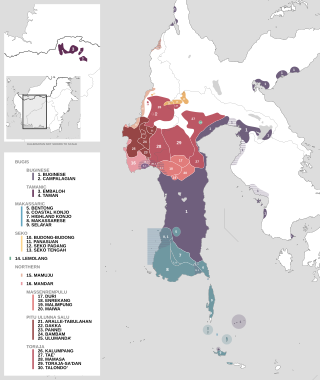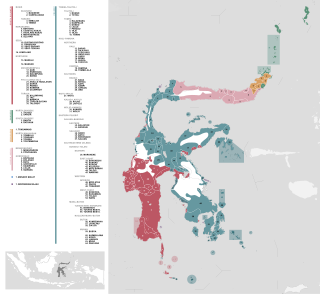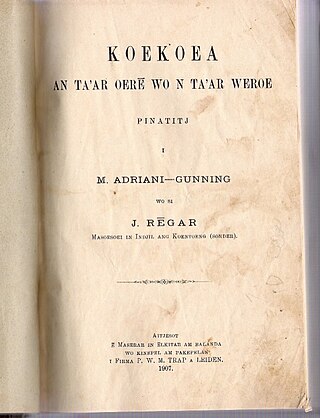Related Research Articles

Malay is an Austronesian language that is an official language of Brunei, Indonesia, Malaysia, and Singapore, and that is also spoken in East Timor and parts of Thailand. Altogether, it is spoken by 290 million people across Maritime Southeast Asia.

North Sulawesi is a province of Indonesia. It is located on the Minahasa Peninsula of the island of Sulawesi, south of the Philippines and southeast of Sabah, Malaysia. It borders the Philippine province of Davao Occidental and Soccsksargen regions of the Philippines to the north, the Maluku Sea to the east, Gorontalo and Celebes Sea to the west and the Gulf of Tomini to the southwest. With the outlying island of Miangas to its north, it is the northernmost island of Indonesia. The province's area is 14,500.28 square kilometres (5,598.59 sq mi), and its population was 2,270,596 according to the 2010 census; this rose to 2,621,923 at the 2020 Census, while the official estimate as at mid 2022 was 2,659,543. North Sulawesi is known as a heaven for divers around the world.
In addition to its classical and modern literary form, Malay had various regional dialects established after the rise of the Srivijaya empire in Sumatra, Indonesia. Also, Malay spread through interethnic contact and trade across the south East Asia Archipelago as far as the Philippines. That contact resulted in a lingua franca that was called Bazaar Malay or low Malay and in Malay Melayu Pasar. It is generally believed that Bazaar Malay was a pidgin, influenced by contact among Malay, Hokkien, Portuguese, and Dutch traders.

The Minahasans or Minahassa are an indigenous ethnic group from the North Sulawesi province of Indonesia, formerly known as North Celebes. The Minahasa people sometimes refer to themselves as Manado people. Although the Minahasan pre-Christian creation myth entails some form of ethnic unification, before the nineteenth century the Minahasa region was in no way unified. Instead, a number of politically independent groups (walak) existed together, often in a permanent state of conflict.
Manado Malay, or simply the Manado language, is a creole language spoken in Manado, the capital of North Sulawesi province in Indonesia, and the surrounding area. The local name of the language is bahasa Manado, and the name Minahasa Malay is also used, after the main ethnic group speaking the language. Since Manado Malay is used primarily for spoken communication, there is no standard orthography.

The Philippine languages or Philippinic are a proposed group by R. David Paul Zorc (1986) and Robert Blust that include all the languages of the Philippines and northern Sulawesi, Indonesia—except Sama–Bajaw and a few languages of Palawan—and form a subfamily of Austronesian languages. Although the Philippines is near the center of Austronesian expansion from Formosa, there is little linguistic diversity among the approximately 150 Philippine languages, suggesting that earlier diversity has been erased by the spread of the ancestor of the modern Philippine languages.
Mongondow, or Bolaang Mongondow, is one of the Philippine languages spoken in Bolaang Mongondow Regency and neighbouring regencies of North Sulawesi (Celebes) and Gorontalo Provinces, Indonesia. With more than 200,000 speakers, it is the major language of the regency. Historically, it served as the official language of the Bolaang Mongondow Kingdom.

The Malayic languages are a branch of the Malayo-Polynesian subgroup of the Austronesian language family. The most prominent member is Malay, which is the national language of Brunei, Singapore and Malaysia, and is the basis for Indonesian, the national language of Indonesia. The Malayic branch also includes the local languages spoken by ethnic Malays, further several languages spoken by various other ethnic groups of Sumatra, Indonesia and Borneo. The most probable candidate for the urheimat of the Malayic languages is western Borneo.
The Gorontalo–Mongondow languages are a group of Austronesian languages spoken in northern Sulawesi, Indonesia.
The Sangiric languages are a subgroup of the Austronesian languages spoken in North Sulawesi, Indonesia and several small islands to the north which belong to the Philippines. They are classified as a branch of the Philippine subgroup.

The South Sulawesi languages are a subgroup of the Austronesian language family. They are primarily spoken in the Indonesian provinces of South Sulawesi and West Sulawesi, with a small outlying pocket in West Kalimantan.

On the Indonesian island of Sulawesi, 114 native languages are spoken, all of which belong to the Malayo-Polynesian subgroup of the Austronesian language family. With a total number of 17,200,000 inhabitants, Sulawesi displays a high linguistic diversity when compared with the most densely populated Indonesian island Java, which hosts 4–8 languages spoken by 145,100,000 inhabitants.
Larantuka Malay is a contact variety of Malay spoken in and around the city of Larantuka on the island of Flores in Indonesia, and in two enclaves: the village of Wure on the island of Adonara and four villages on Konga Bay, about 40 kilometers south of Larantuka on Flores, and serves more generally as a lingua franca on the eastern tip of Flores and nearby islands. There are approximately 23,000 native speakers of Larantuka Malay. Second language speakers of Larantuka Malay are primarily found in and around the city of Larantuka and through the eastern part of Flores island, as well as the nearby islands of Adonara, Solor and Lembata (Lomblen), and natively speak Lamaholot or other languages closely related to Lamaholot, which, until recently, were believed to be dialects of Lamaholot.
Ternate is a language of northern Maluku, eastern Indonesia. It is spoken by the Ternate people, who inhabit the island of Ternate, as well as many other areas of the archipelago. It is the dominant indigenous language of North Maluku, historically important as a regional lingua franca. A North Halmahera language, it is unlike most languages of Indonesia which belong to the Austronesian language family.
Tombulu, also known as Minahasan language, is an Austronesian language of northern Sulawesi in Indonesia. It is a Minahasan language, a sub-group of the Philippine languages.

Tontemboan is an Austronesian language, of northern Sulawesi, Indonesia. It is a Minahasan language, a sub-group of the Philippine languages.
Tondano is an Austronesian language spoken in the Tondano area of northeast Sulawesi, Indonesia. It is most similar to Tombulu and to Tonsea.
Tonsawang, also known as Tombatu, is an Austronesian language of the northern tip of Sulawesi, Indonesia. It belongs to the Minahasan branch of the Philippine languages.
Bacan Malay or Bacan is a Malayic language spoken on the island of Bacan in North Maluku province, Indonesia, by the minor Bacan ethnic group. It is an anomalous presence in the region, being surrounded by genetically distant Austronesian languages and languages of the unrelated North Halmahera family. Bacan is geographically removed from the Malay heartlands in the western archipelago.
James Neil Sneddon is an Australian linguist who specializes in Indonesian and languages of Sulawesi.
References
Notes
- ↑ Watuseke, F. S. (1965), "Kata-kata Ternate dalam bahasa Melaju-Manado dan bahasa-bahasa Minahasa", Pembina Bahasa Indonesia (in Indonesian), IX: 107–110
- ↑ Schouten, M. J. C. (1998), Leadership and social mobility in a Southeast Asian society: Minahasa, 1677–1983, Leiden: KITLV Press, pp. 39–40
- ↑ Watupongoh, Geraldine Y. J. Manoppo (1992), Struktur bahasa Tondano (in Indonesian), Jakarta: Pusat Pembinaan dan Pengembangan Bahasa, Departemen Pendidikan dan Kebudayaan, p. 2
- ↑ Henley, David (1996), Nationalism and regionalism in a colonial context: Minahasa in the Dutch East Indies, Leiden: KITLV Press, p. 86
- ↑ Sneddon (1978), p. 9.
- ↑ Adelaar (2005), p. 16.
- ↑ Watuseke, F. S. (1956), "Bahasa Tondano", Bahasa dan budaja (in Indonesian), 4/5: 3–14
- ↑ Watuseke, F. S. (1977), "'Kolano' in the Tondano Language", Papers in Borneo and Western Austronesian linguistics No. 2 (PDF), Pacific Linguistics A-33, C. Court, R. A. Blust, F. S. Watuseke, Canberra: Department of Linguistics, Research School of Pacific Studies, Australian National University, pp. 123–132, doi:10.15144/PL-A33 , retrieved 2022-12-24
- ↑ Sneddon (1978).
- ↑ Sneddon (1989), p. 85.
Bibliography
- Sneddon, James N. (1978). Proto-Minahasan: phonology, morphology, and wordlist . Pacific Linguistics B-54. Canberra: Austronesian National University. doi: 10.15144/PL-B54 . ISBN 9780858831698.
- Sneddon, James N. (1989). "The North Sulawesi Microgroups: In Search of Higher Level Connections". In Sneddon, James N. (ed.). Studies in Sulawesi Linguistics, Part 1 (PDF). NUSA Vol. 31. Jakarta: Universitas Katolik Atma Jaya.
- Adelaar, Alexander (2005). "The Austronesian languages of Asia and Madagascar: a historical perspective". In Adelaar, Alexander; Himmelmann, Nikolaus (eds.). The Austronesian languages of Asia and Madagascar. London: Routledge.